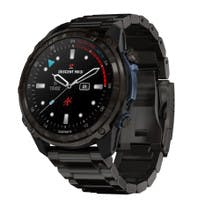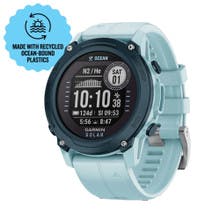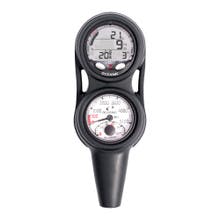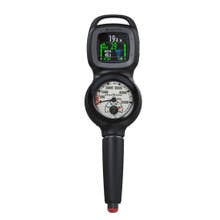How to Buy a Dive Computer


Cindy, Dive Computer Guru— With 32 years of diving, I’ve seen the shift from dive tables to dive computers. As technology advances, the features and functions of dive computers evolve, making diving safer.
If you’re a new diver looking for information on dive computers, welcome. If you have a few hundred dives under your belt and are looking at updating your dive computer, welcome. While more advanced divers will likely already know what kind of computer they’re looking into getting, both novice and advanced divers will get some helpful tips for choosing a device that’s right for them. Let’s dive in, shall we?
What is a Dive Computer?
A dive computer is a technological device designed for scuba divers. This device gathers information from a dive session such as depth and elapsed time. The device then uses this information to calculate safe and appropriate bottom time and ascent speed. The main purpose of a dive computer is to help prevent decompression sickness which is why it is sometimes known as a decompression computer. Dive computers can also be used to pre-plan your dive. This allows you to prepare and communicate with your dive buddy for your dive. Dive computers achieve these safety calculations by using algorithms which can vary between computer brands and styles. Some are more conservative (less bottom time and slower ascent) while others are more liberal (more bottom time and faster ascent). Another function of your dive computer is the ability to log your dives more efficiently and accurately.
Why do I need a dive computer?
The answer is fairly simple: for an easier and safer dive experience. Technically, with the use of dive tables that you learned in your scuba diving classes, you don’t need a computer. However, just like calculators save you time and provide greater accuracy, you’ll save valuable dive time by letting your computer do the thinking for you (and you won’t have to second guess your own calculations). Please note, you should still study your dive tables and get to know them. You never know when or if you’ll need to apply them. But a dive computer makes for a much more pleasant experience all together.
With some computers, even your dive logging experience is easier. Some dive computers connect to your PC or smartphone. With the click of a button, you easily fill in your virtual logbook. But we’ll explore the details of that later.
What do dive computers do?
Well, dive computers have the potential to do all kinds of things. The most important functions of a dive computer calculate your depth, elapsed dive time, and no decompression limit. Your safety is the main purpose, while a more enjoyable dive is a close second. A dive computer allows you to know your depth and rate of ascent so you can avoid that nasty decompression sickness (DCS). Each dive computer has these core functions for your safety, but other additional features can vary depending on the computer.
What kind of dive computer should a new diver get?

If you’re new to the world of diving and you start to shop around for a dive computer, the long lists of features, different styles, and even the technical terminology can seem rather overwhelming at first glance. The best advice we can offer when you’re about to drop some serious dollars on your first dive computer is play around! Go to your local Divers Direct and ask about the selection of dive computers and each of their features and benefits. Do loads of online research if you can. Just get to know all you can about as many different computers as you can. That will help you feel out and analyze what might be the right computer for you.
Additionally, as a beginner, it’s never a bad idea to start with a simpler, less expensive device. Using something simple to start off with will get you familiar with using a computer underwater. Also, you won’t have to worry about trying to understand the different features you may not even need as a new diver. With something simple, you’ll only need to learn the necessary features the computer comes. This way, you can focus on building your dive skill set and enjoying your dive rather.
What kind of diver do I see myself becoming?
That can possibly seem like an unanswerable question right now, especially if you only have a few dives in. However, you may already have an idea about your diving aspirations. You may already be hoping to advance to deep diving and other dangerous fun. Perhaps you may already be set on sticking with recreational diving. Basically, the answer to that question will let you know if you’ll only need a basic dive computer, or if you’ll want a computer that has room to grow while you do.
A Tip for the Not-So-New Divers:
It’s possible that you’ve used the same dive computer you’ve had since you were a novice diver. Maybe you’ve had a few dive computers already and you’re looking for something that's a better fit for your nautical needs. Either way, if it’s time for a new device, here are some questions you may want to ask yourself about your current computer: What feature or features do you feel may be lacking from your current computer? Do you wish it could do more? Like what? Do you feel the algorithm could be adjusted to better suit you? Think about the things that may make your dive experience even easier or more pleasurable. Dive computers have come a long way. It’s possible to find something that not only meets your needs, but exceeds them as well.
Dive Computer Considerations for the Novice, the Advanced, and every Diver in between:
Whether you’re shopping for your first dive computer or your fifth, there are a few things to consider when browsing around for new gear.
First of all, you need to get a general idea of what your budget is for this equipment. Dive computers have a wide range of prices averaging from around $150 to $1,500. That’s a huge jump and every kind of dive computer you can think of fills the space between. Keep in mind—less expensive doesn’t necessarily mean a poor product. Equally so, an extravagant price tag doesn’t always make something the best. The best product is the product that’s the best for you—simple as that. Once you’ve considered your budget, search within that range and try to find everything you need within that number. Don’t worry, whatever your budget is, you should still be able to find a suitable dive computer with a variety of features.
Something else to consider is whether or not you want your computer to be air integrated. An Air Integrated dive computer analyzes how much air or nitrox is left in your tank and adds the information to your computer’s screen. This is obviously a desirable feature but can add on to the product’s price significantly.
Speaking of air, if you use or potentially plan to use Nitrox on your dives, it’s a good idea to have a dive computer that can switch between gases and has a range Nitrox capability. New Divers, just so you know, diving with Nitrox requires some additional training, but it can increase both the length of your dives and the safety. Most dive computers come with this capability, but it’s always a good idea to double check.
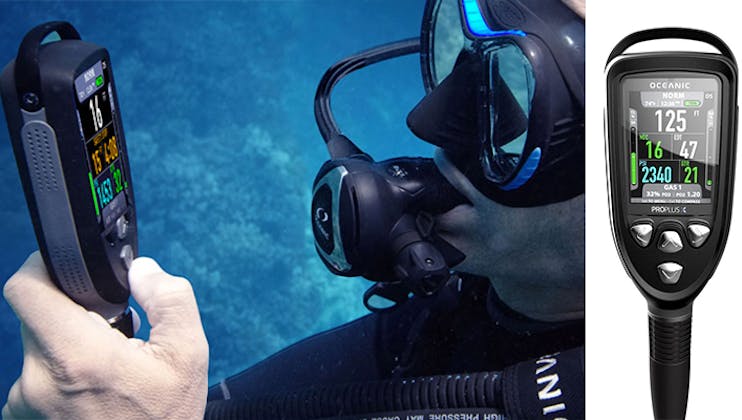
Perhaps the most important aspect of your dive computer is its algorithm. This is the feature that is most concerned with your safety, tracking the amount of nitrogen you’re absorbing into your bloodstream while you’re down. Amazingly, there are multiple algorithms out there in the dive computing world. Some algorithms are more conservative than others which really just means they calculate a slower ascent with more/longer stops.
Suunto computers are known to use highly conservative algorithms. If you’re a less experienced diver, a more conservative algorithm is a good place to start. These allow for more bottom time but a faster ascent. Some computers let you adjust the algorithm when you figure out your body’s ascending preferences and capabilities. Other computers can self-adjust in response to your current biometrics.
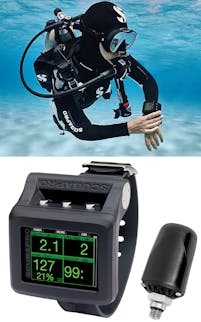
If you’re only planning on diving when you go on that annual vacation to the Florida Keys or when you finally save up enough for that trip to Hawaii or Indonesia, you won’t be needing much log memory in your computer. This is because you’ll likely get home or to the hotel and transfer your dive info right then and there, waiting until next year or next vacation to do it all over again. But if you live near a rad dive spot (or many dive spots) and plan on making every possible dive you can, you may want more memory capacity for your computer so that you don’t have to upload your log info every single time you get out of the water.
If you envision yourself as a traveling scuba diver, you’ll be high in a plane, then down to the depths of the sea, then back high on a plane again. If you’re not careful, this could be dangerous. A really great feature for a dive computer to have for anyone who plans on taking their dives to new places is a no-fly time calculator. Once you get out of the water, you need to wait a certain amount of time before you can get on a plane and fly back home or to your next destination. Instead of dealing with the anxiety of hoping your own calculations are correct, the accuracy of a dive computer can certainly help you stay safer on your travels. So, get yourself a computer with this feature if you have an international dive location in mind already—you’re going to need it!
And finally, how would you like to mount your dive computer? You can access your information from a console/boot mount connected to your BCD, like with the Mares Mission Puck 2 Dive Computer. Another option is to view it wirelessly on your wrist with something like the Suunto D5. The third option is to have the information projected right onto your mask lens when using a computer like the ScubaPro Galileo HUD.
When thinking about your computer mounting, the most important factor to consider is how comfortable you are with the device. Does it seem too bulky? If you’re exploring a wrist computer, are the straps comfortable? What about the screen size? Sure, a smaller screen may mean greater comfort, but it could also mean more difficult readability. And beyond practicality, what about style?
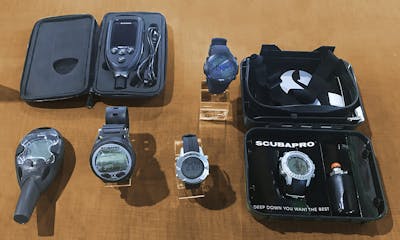
Do you want a computer that can venture with you on land and help your scuba skills when you’re not even in the water? The Garmin Descent Mk3i Computer is stylish enough for you to wear into the office after your morning dive, has a heart-rate monitor to keep up with your exertion while you dive, and your endurance training on the surface. If you’re exploring a console computer, will you mind the extra equipment hanging from your BCD, or could you feel like you have too many techy tentacles floating around your tank? While a wrist mount is certainly the most popular mounting style since it’s wireless and you always know where to find it, will you mind the bulky bit of gear on your wrist? Again, comfort is key, and you’ll find your own mounting preference once you try them out.
Don’t Call It a Comeback—Analog Gauges
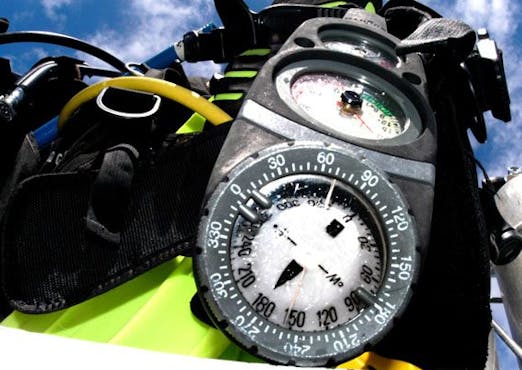
It’s easy to get caught up in what’s new in the infinitely evolving world of technology. Sometimes it’s a good idea to stick with tried and true methods. All you need are your analog gauges, your mind, and your intuition to guide your way through your dive. Digital dive computers simplify the process. However, if you’re the kind of person that relies on your mind more than you rely on technology, using analog gauges and your tables may be the most comfortable route for you. Especially if you’ve been using this system for years of diving and it’s been working pretty well so far.
If you’re a new diver though and you start looking into analog gauges, you’ll immediately notice the simplicity in use and information. Where you may have looked at digital computers and thought, “What am I even reading right now?” When you read up on a specific analog gauge, it will likely be pretty straight forward. Additionally, you’ll be trusting yourself to know the time table for ascent depending on the dive.
Every analog console will at least tell you your tank pressure. If you do not want an air integrated digital dive computer, you’ll be getting one of these analog gauges regardless. But, to make your mind the computer here, you’ll need a depth gauge as well. Some consoles come with both. The only additional feature you’ll be able to add on to your analog console is a compass, seen here with the Mares Mission 3 Gauge Console. This analog console has everything you need to get your underwater brain going when calculating your bottom time and get your fins flipping in the right direction.
Other Nifty Tools
Even if you don’t have analog gauges at your side and are perhaps using a digital wrist computer, you’ll still need a Dive Compass to help you navigate your adventure. Google Maps won’t help you find that shipwreck, but a good, old fashioned compass sure will. You can either attach it to your BC, string it on your wrist band, or even get a slate with a compass attached to the top if you prefer. There are a few options here. The question is, where will you feel it’s comfortably mounted and convenient to locate.
So, you’ve picked out your dive computer, or maybe you feel like you’re on the right track towards it anyway. What now? Well, ideally, everything you need will come in one package. If you just dropped a thousand dollars on a wrist computer, you’re going to want to protect and preserve it. So, maybe you get yourself a screen protector for your new computer. You could also possibly need a tank transmitter for your air integration. Or maybe you like to stay ultra-prepared and want to keep an extra battery on you. Either way, some Computer Accessories could help you stay prepared and keep your gear protected.
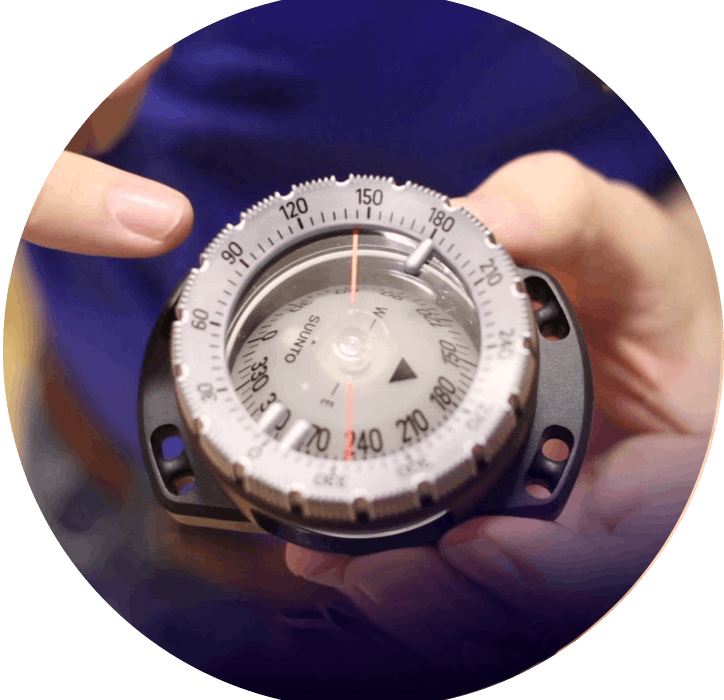
Suunto SK8 Wrist Dive Compass
The Short of It
Basically, there’s no quick answer for the question, “What dive computer should I get?” Regardless whether you’re brand new or you've been around the reef a few times, you’re going to have to do some work and research to find the right style of computer for you. Now you have key features to look out for and questions to ask on your search for the right equipment. Remember, the whole purpose of a dive computer is for safety and convenience. Find something that’s comfortable, easy to read and understand, and has the key features you’re looking for.
FAQs
What is a dive computer?
A dive computer is an electronic device used by scuba divers to measure and display various dive parameters in real time, such as depth, time, and no-decompression limits. It helps divers manage their dive profiles to avoid decompression sickness.
How does a dive computer work?
A dive computer uses sensors to monitor depth and time, applying decompression algorithms to calculate safe ascent profiles. It continuously updates information on no-decompression limits, ascent rates, and surface intervals to ensure safe diving practices.
What is no-decompression limit (NDL) on a dive computer?
The no-decompression limit (NDL) is the maximum time a diver can stay at a certain depth without needing to perform decompression stops during ascent. Dive computers calculate and display this limit in real time, helping divers avoid decompression sickness.
How do I care for and maintain my dive computer?
Rinse your dive computer with fresh water after each dive to remove salt and debris. Store it in a cool, dry place, avoid exposing it to extreme temperatures, and regularly check for firmware updates. Replace batteries as needed and have it serviced by a professional if required.
Can I use my dive computer for different types of diving?
Yes, most dive computers are versatile and can be used for recreational, technical, and freediving. Ensure your dive computer has the appropriate settings and features for the type of diving you plan to do, such as gas mix support for technical diving.

